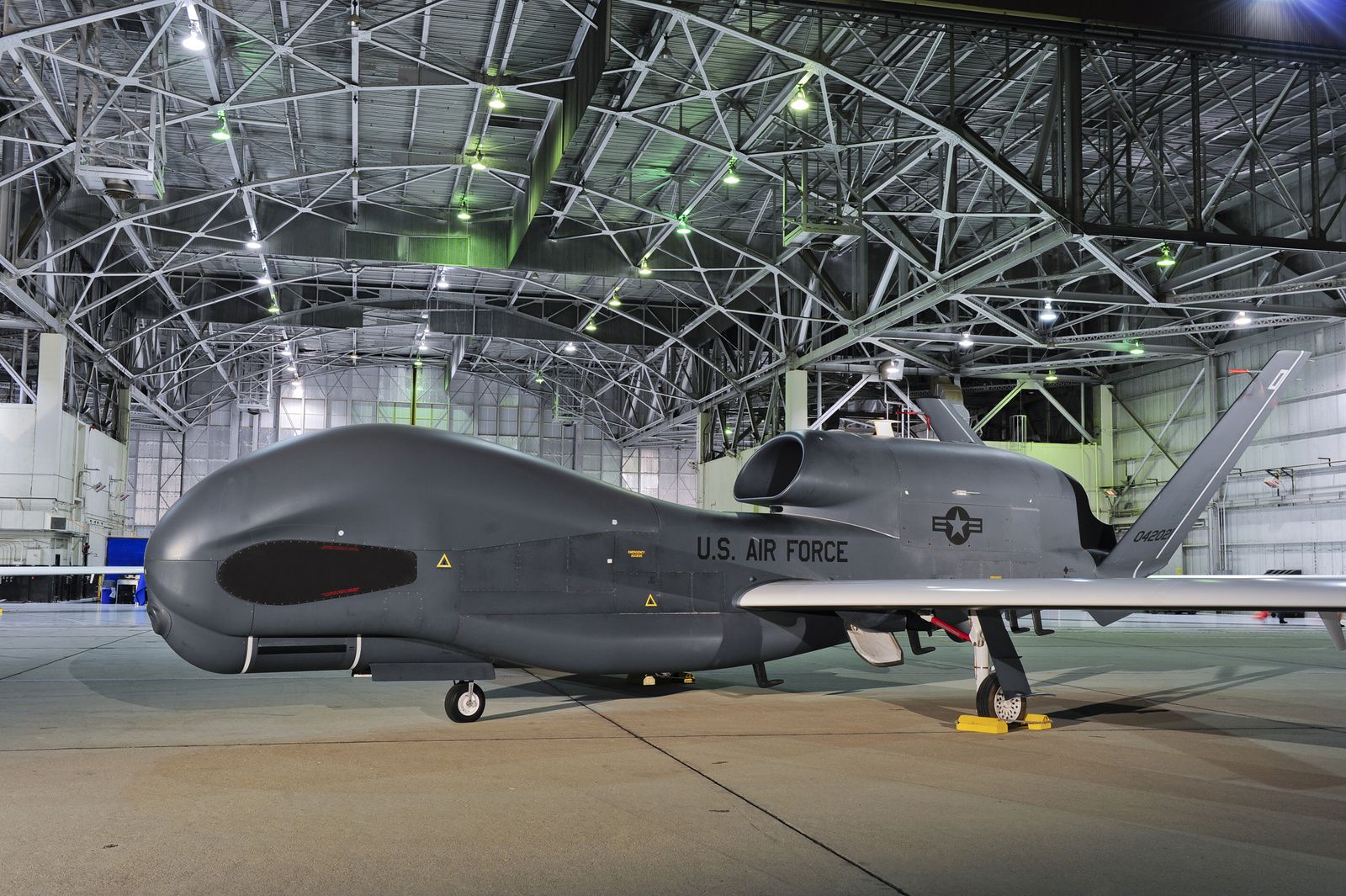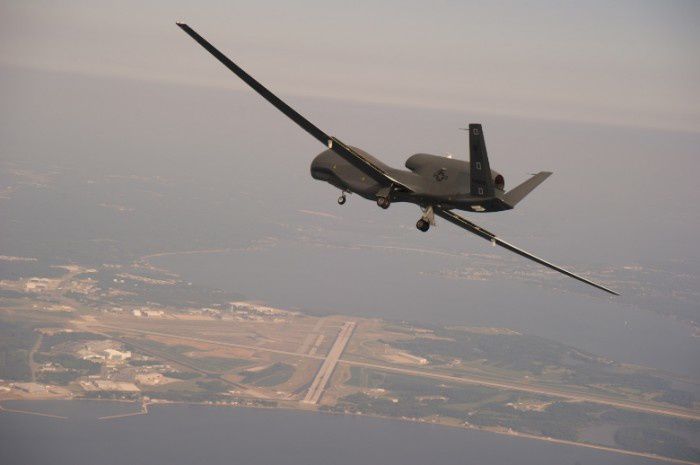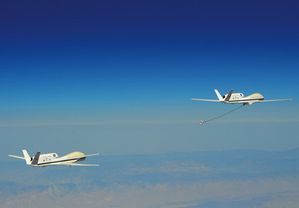June 25, 2014: Strategy Page
The U.S. Air Force has changed its mind about the RQ-4 Global Hawk UAV. The motivation here is the need to cut costs in the face of a shrinking air force budget. So now the air force is asking Congress for two billion dollars to upgrade some RQ-4s so they can fully replace the versatile, elderly and expensive-to-operate U-2 reconnaissance aircraft. The air force is saving a lot of money by retiring entire types of aircraft (like U-2s and A-10s). The A-10s will be completely replaced by F-16s and smart bombs.
For years the air force was dissatisfied with the performance and operating costs of the RQ-4, pointing out that the U-2 was cheaper and, because of better sensors, more useful. But the RQ-4 manufacturer brought down the costs and increased reliability. Despite that criticism from the U.S. Air Force, American aircraft manufacturer Northrop Grumman continued to find customers for its RQ-4. In large part that’s because the RQ-4 has been much improved since 2010. The RQ-4 has become more reliable, efficient and flexible. Several of the new customers (like South Korea and Japan) want to use it for maritime reconnaissance, something the U.S. Navy is already doing. The cost of operating the RQ-4 has also been greatly reduced over three years, from $40,600 an hour to $18,900. That happened largely because there were more RQ-4s in service and each was flying more hours. That spread overhead costs over more flight hours. There was also a sharp reduction (by $14,000 an hour) in contractor support costs, largely brought on by improved aircraft reliability. Another factor driving this decline in costs was the air force threat to get rid of many RQ-4s because it was cheaper, per flight hour, to use the much older manned U-2s. Now that is no longer the case and the air force has backed away from dropping its RQ-4s and instead wants to retire the U-2s instead.
Back in 2011 the U.S. Air Force very publically gave up on the RQ-4. This came in the form of an air force announcement that they had stopped buying the RQ-4. Not only that but ten of the thirty-one Block 30 models ordered were cancelled. None of the planned Block 40 aircraft were to be built. Global Hawk remained in production because there were other users who were not as displeased as the air force. The U.S. Navy is buying 68 MQ-4C “Triton” BAMS (Broad Area Maritime Surveillance) models plus the two prototypes. Triton is to enter service by 2017.
While the RQ-4 has always been hailed as a revolutionary and successful system, most of the recon and surveillance jobs in the last decade were handled by the more reliable, cheaper, and numerous Predator and Reaper UAVs. Meanwhile, the air force was having more and more problems with the RQ-4, and that led to the public denunciation of the RQ-4 and Northrop Grumman. But as the war on terror dies down and the potential opponents include countries with air defenses, the higher flying RQ-4 becomes more valuable.
The 2011 decision was the result of the air force and the manufacturer feuding over design, cost, and quality control issues. The last straw was the unreliability of the new Block 30 models. This renewed Department of Defense threats to cancel the program. But manufacturer Northrop Grumman lobbyists have made sure the key members of Congress knew where Global Hawk components were being built and how many jobs that added up to. While that delayed the RQ-4 Block 30 cancellation it did not stop it. The air force was placated for a while when Northrop Grumman fixed some of the problems (some of which the manufacturer said don't exist or didn't matter). The Block 30 was supposed to be good to go, but the air force was not convinced and decided that Block 30 was just more broken promises. Congress was also tired of all the feuding and being caught between Northrup lobbyists and exasperated air force generals. Then there was political decision to cut the defense budget over the next decade. Something had to go.
You'd think the RQ-4 would be somewhat perfected by 2011. It was closer to that than many believed and is now considered a lot more reliable. Development of the RQ-4 began in the 1990s, as a DARPA research project. By 2006, per-aircraft costs were twenty-five percent over the original price. By 2007, production schedules had slipped as well. The air force and Northrop Grumman disagreed over what caused these problems. The air force blamed it on poor management. Northrop Grumman said it's all about dealing with complex technology. The air force pointed out that the RQ-4 was not high tech. The sensors often are but they are added to the aircraft after they came off the production line. Northrop Grumman continued to stonewall the air force and showed no signs of making any basic changes. Some air force procurement officials believed Northrop Grumman diverted resources to foreign customers, while taking advantage of the fact that there was no other supplier the air force could go to for long range UAVs. There was a lot of bad blood between the user and the manufacturer, which is not a good thing.
There were sixteen of the RQ-4A ("Block 10") aircraft built, fourteen for the U.S. Air Force, and two for the U.S. Navy. The later models were the larger RQ-4B (block 20, 30, and 40). Production has been consistently behind what Northrop Grumman had earlier promised. The air force originally planned to buy over forty Block 30s and wanted to get them faster, and with the reliability problems fixed. That did not work out before the war on terror largely ended and with it the big defense budgets.
In 2011, the air force transferred its remaining seven early model (Block 10) RQ-4s to other government agencies. These UAVs began flying nearly a decade ago and each has spent, on average, some three-thousand hours in the air. Some have spent over seven-thousand hours in the air, while others have mostly stayed on the ground. On average, these Block 10 aircraft flew once a week. But some ninety percent of hours flown were in combat operations. Subsequent models (Block 20, 30, and 40) had greater carrying capacity and reliability. Many payloads (various sensors) are designed for the larger models. But the Block 10 is still useful for civilian missions (disaster monitoring, border patrol, and all sorts of research).
Things had started off on a more promising note. The RQ-4 was still in development on September 11, 2001, but was rushed into action. The first production RQ-4A was not delivered until August, 2003. Although the RQ-4 could stay in the air for up to forty-two hours, all of them had only amassed about four-thousand flight hours by 2004. But most of those four-thousand hours, which were originally planned to involve testing of a new aircraft, were instead used to perform combat missions. Global Hawk also got to fly under difficult conditions, something an aircraft still being developed would not do.
In 2008, an RQ-4A Global Hawk made the first non-stop crossing of the Pacific, flying twelve-thousand kilometers from California to Australia in twenty-three hours. The Global Hawk has previously crossed the Pacific in several hops but it always had the endurance to do it non-stop. In the last decade RQ-4s have flown over fifty-five-thousand hours, most of that combat missions, and many of them from Persian Gulf bases. The latest models can fly twenty hour missions, land for refueling and maintenance, and be off in four hours for another twenty hours in the sky. But the reliability issues with the Block 30 made the longer missions infrequent. Otherwise, the RQ-4 has been very reliable, with aircraft being ready for action ninety-five percent of the time. An RQ-4 can survey about four-thousand square kilometers an hour.
The U.S. Air Force pays over $150 million for a fully equipped RQ-4, but only about 35 percent of that is for the UAV itself. Include payload (sensors and communications) and development costs and it nearly triples. The B version is about ten percent larger (wingspan of 42.3 meters/131 feet, and 15.5 meters/48 feet long) than the A model and can carry an additional two tons of equipment. To support that, there's a new generator that produces 150 percent more electrical power. The B version is a lot more reliable. Early A models tended to fail and crash at the rate of once every thousand flight hours, mostly because of design flaws. It was those flaws and delays in fixing them that got the air force so angry. The first three RQ-4Bs entered service in 2006, with some of those flaws still present, and it took over five years to clear that up.
At thirteen tons the Global Hawk is the size of a commuter airliner (like the Embraer ERJ 145) but costs more than twice as much. Global Hawk can be equipped with much more powerful, and expensive, sensors than other UAVs. These sensors comprise most of the cost of the aircraft. The spy satellite quality sensors (especially AESA radar) are usually worth the expense because they enable the UAV, flying at over 20,000 meters (60,000 feet), to get a sharp picture of all the territory it can see from that altitude.

























